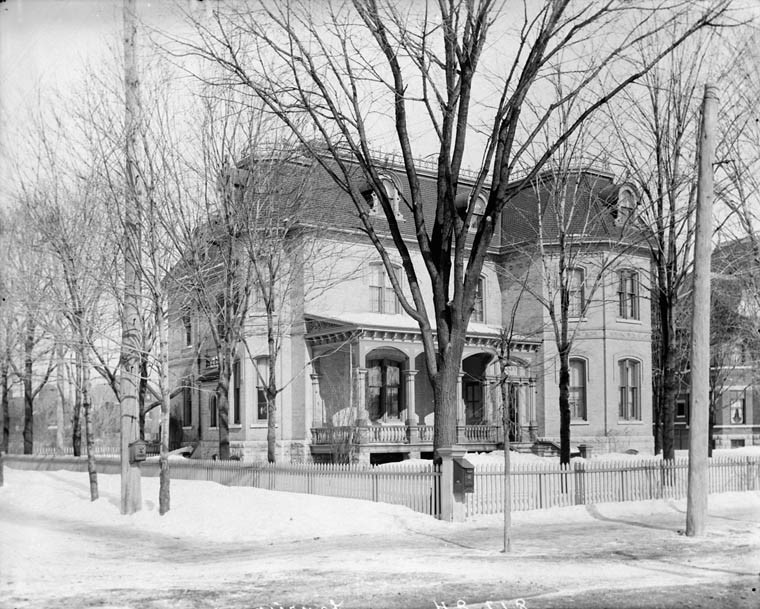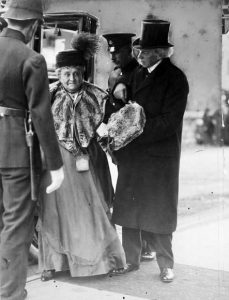Sir Wilfrid Laurier
1841-1919
Laurier was the first French-Canadian prime minister serving from 1896 to 1911. He championed national unity, promoted the construction of the Grand Trunk Railway, created the provinces of Alberta and Saskatchewan and supported the settlement of the Prairies.
Before he was elected prime minister, Laurier rented a room at the Russell Hotel, as did many other federal politicians at the time. After his election, Laurier needed a large house, something he could not afford, as he was now expected to entertain dignitaries and party faithful in style. A grateful Liberal Party purchased 335 Theodore St. (now Laurier Ave. E.) at the corner of Chapel St. This graceful second empire yellow-brick house was probably designed by James Mather who also built 453 Laurier East, now home of the Cordon Bleu Culinary Arts Institute. As executor for the previous owner, Richard Scott (a former mayor of Bytown, future senator and member of Laurier’s cabinet) handled the $9500 transaction. Laurier lived there between 1897 and the year of his death in 1919; his wife Zoë stayed in the house two more years until her own death in 1921.
Laurier House, as it is now called, was vibrant and busy when the Lauriers lived there, with relatives and visitors often remaining on extended stays (one niece lived with the Lauriers for six years). The atmosphere was informal and more that of a private home than a formal government residence. Laurier is widely remembered as gracious, charismatic and a gentleman who could charm any audience. Lady Laurier liked to entertain (she was an accomplished piano player) and often had groups of women friends coming for tea or to play cards. She also kept several pets, including two pomeranians.

The Lauriers would often host formal dinners twice a week as well as an informal lunch on Sunday. Zoë entertained her friends on Monday, Thursday and Saturday afternoons while Sunday afternoons were reserved for the more formal ‘At Home’ invitations. Not surprisingly, such entertainment required an extensive staff and the Lauriers employed a live-in cook, butler, lady’s maid and two additional maids.
A story in Toronto Saturday Night on December 8, 1906 recounts a reception upon the start of the new parliamentary session:
The event par excellence of the week was a large and brilliant reception on Wednesday evening by Sir Wilfrid and Lady Laurier, especially to welcome the cabinet Ministers, senators and members of Parliament and other officials who, with their wives and daughters, are now assembled here for the session. The brightly lighted rooms of the Premier’s spacious residence were very effectively arranged with hosts of flowers, palms and ferns … which adorned the long buffet in the dining room where refreshments were served. … During the evening an orchestra played at intervals in the hall, and much additional pleasure given the guests on hearing Miss Eva Gauthier[1] sing most charmingly several pretty solos… .
Earlier that day, Mrs. Borden, the wife of the Leader of the Opposition, had hosted the first of two afternoon teas “…in their handsome and very artistic residence in which they have just settled, in Wurtemburg St. … . Over five hundred invitations had been sent out for each afternoon, and included all the Senators and M.P.’s, a great many of whom were present with their wives and daughters”.

As prime minster, Laurier’s daily routine involved getting up by 8 a.m., breakfast at 9 (reading The Ottawa Citizen) and correspondence until 10:30 when he would go to Parliament Hill. He would come home for dinner around 6:30 and return to the Hill in the evening when the House was in session. When the House was not sitting, he would stay at home reading or writing. His personal library had over 5000 books.
Until he purchased a car in 1909, Sir Wilfrid often went to the office by streetcar on the line that used to run by his front door[2]. His successor Sir Robert Borden who lived on Wurtemberg St, close to Rideau St., would later do the same (and sometimes bicycled to the Hill). We know that Lady Laurier was riding a car in 1910 because she received a ticket for speeding on Bank Street: her chauffeur was driving faster than ten miles an hour, the speed limit at the time.
Laurier jokingly called his wife his “Minister of Public Charity” because, although she had no official role in government, she took an active interest in patronage appointments. She would vet all requests for favours addressed to her husband and leave him her recommendations in a wicker basket. She also did not hesitate to lobby ministers on behalf of certain clients. When Laurier created a public service commission to oversee hiring and appointments, he apparently told his wife “My poor dear, you have lost your job!”
Shortly after he became prime minister, Laurier appointed his former law partner Joseph Lavergne to the Quebec Superior Court Hull district. Laurier had a close personal relationship to Mr. Lavergne’s wife Emilie who was his confidante, advisor and perhaps also lover. For several years, until Laurier grew estranged from Emilie and moved her husband to the Superior Court in Montreal in 1901, the Lavergnes lived just two blocks away at 459 Theodore. Emilie had a large influence on Laurier, writing after their estrangement “I taught him then to eat, to dress with taste, in a word, all that a gentlemen should know”. (S Gwyn, 1980)Emilie Lavergne’s son Armand, who became a strong Quebec nationalist and sat in the Quebec National Assembly, resembled Laurier physically and may have been his son.
After his death, Laurier’s body was exposed at the Victoria Museum (now the Canadian Nature Museum) as the Parliament buildings had not yet been rebuilt after the 1916 fire. His funeral was originally to have been held at his parish church, Sacré Coeur at the corner of Cumberland St., but to the disappointment of the local priest, the Catholic Archbishop pulled rank and decreed that the funeral would be held in the Basilica on Sussex Ave. instead. Laurier is buried in Notre Dame cemetery on Montreal Rd.
[1] See separate write-up under Other notable individuals.
[2] Laurier took the streetcar home from his office after suffering the first of the strokes that killed him two days later.
